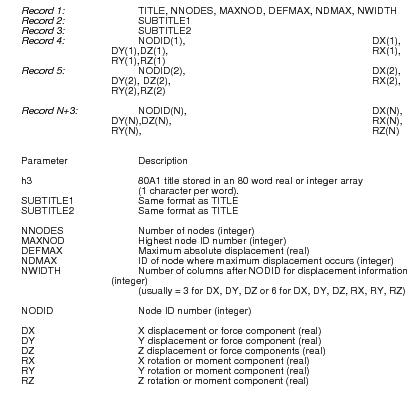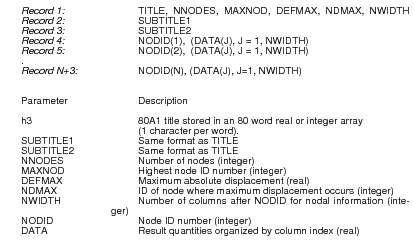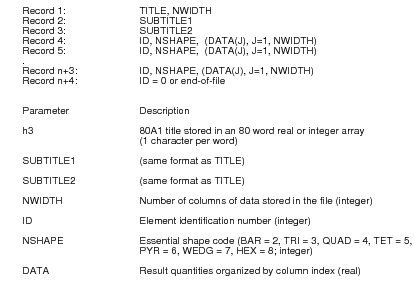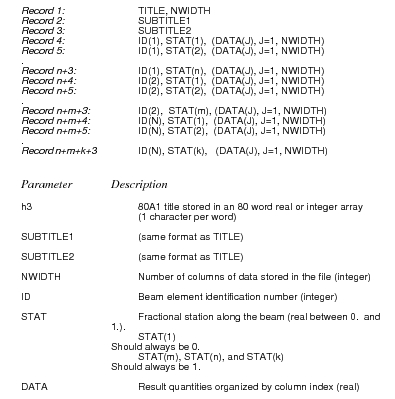XXXXXXXXXXXXXXXXXXXXXXXXXXXXXXXXXXXXXXXXXXXXXXXXXXXXXXXXXXXXXXXXXXXXXXXXXXXXXXXXXXXXXXXXXXXXXXXXXXXXXXXXXXXXXXXXXXXXXXXXXXXXXXXXXXXXXXXXXXXXXXXXXXXXXXXX''"> A.5 PATRAN 2.5 Results Files
All results obtained from an external analysis code (other than the P/FEA module) were written to one of five different types of PATRAN 2.5 -compatible results files in order to be processed by PATRAN 2.5: a DISPLACEMENT, FORCE, NODAL, ELEMENT, or BEAM Results File.
In this section, we will outline the formats of the various results file types. The information contained in this section can be used to write translators for your own in-house analysis codes or for test data.
Displacement or Force Results Files
Displacement results files are a special case of the NODAL RESULTS FILES described in
Nodal Results Files, 756. Displacement results files contain the displacements calculated by the analysis code at the node points. There are usually 6 columns in a displacement result file. The first 3 are the X, Y and Z components of translation and the second 3 are the X, Y and Z components of the rotation at the nodes. A single column of a displacement results file can be used for contouring. For example, to contour the Y-component of displacement. Patran will also postprocess the first 3 columns to contour the resultant displacement and/or to provide deformed mesh plots. Displacement or rotations vector plots can also be generated.
Force results files have the same format as displacement results files. The only difference between the two is that a force file contains the forces and moments at nodes instead of displacements and rotations. Force results files can be used to generate force or moment vector plots. For example, reaction forces are commonly displayed this way. Weld element results are also calculated from the results in a force results file containing node force balances.
Most Analysis Model translators create a different DISPLACEMENT or FORCE RESULTS FILE for each load case. If you desire to write your own results translator from your own in-house analysis program, you should load the results in the scheme mentioned above: X, Y, Z translations or forces followed by X, Y, and Z rotations or moments.
Patran will interpret the X, Y, and Z values of displacement, force, rotation, or moment in the coordinate system defined in the associated
Patran 2.5 Results Files, 46.
Both a binary and a text version of displacement and force results files are supported in Patran. The format of the file will be automatically determined before reading in the data.
Sample Displacement/Force Results Data File
Binary Version
Text Version
Nodal Results Files
Nodal results files contain the results quantities that have been calculated at the node points. Up to 200 columns of results quantities can be stored for each node. Patran will process a single column of a nodal results file at a time and use that data to produce contour plots. Patran allows nodal results files to be used for element color-coding by averaging the data at the elements. Nodal results files can also be used for vector plotting and x-y plotting.
Most analysis model translators create a different nodal results file for each load case. Each of the MSC supported translator documents contains a table listing the type of results stored in each column. If you desire to write your own results translator from your own in-house analysis program, you must document the results contained in each column of the results file. A user can then process a particular column knowing that the required results quantity was put in that column by the translator.
Both a binary and a text version of nodal results files are supported in Patran. The format of the file will be automatically determined before reading in the data.
Binary Version
Text Version
Note: | MAXNOD, DEFMAX, NDMAX can be set to zero unless it is a displacement results. |
Sample Nodal Results Data File
2 2 0 0 10
h3
SUBTITLE 2
1 +2.42755E+00 +2.93590E+00 +1.55693E+00 +1.01315E+00 +4.32207E-01
+1.08574E+00 +3.02910E+00 +3.80189E+00 +3.39958E-01 +1.63880E+00
2 +1.14613E+00 +2.32387E+00 +2.76658E+00 +7.53095E-01 +5.10357E-01
+2.12205E+00 +4.33402E+00 +4.41597E+00 -5.84647E-01 +1.74512E+00
Element Results Files
Element results files contain the elemental results quantities for each Analysis Model element analyzed. Up to 200 columns of results quantities can be stored for each element. Patran will process a single column of an element results file at a time and use that data to color code elements. Element results files can be used for contouring; however, the data read from the element results file will be averaged at the nodes in order to be able to produce contour plots. Element results can also be used for x-y plot data generation.
Most Analysis Model translators create a different ELEMENT RESULTS FILE for each load case. Each of the MSC supported translator documents contains a table listing the type of results stored in each column. If you desire to write your own results translator from your own in-house analysis program, you must document the results contained in each column of the results file. A user can then process a particular column knowing that the required results quantity was put in that column by the translator.
Both a binary and a text version of element results files are supported in Patran. The format of the file will be automatically determined before reading in the data.
Binary Version
Text Version
Sample Element Results File
19
STRESS/STRAIN AT TIME: .00500058
1 4
.1483126E+05 .1492715E+05-.3057466E+03 .2852407E+01-.5369175E+01 .0000000E+00
.9919469E+04 .1488886E+05-.8247605E+04-.8088444E+04 .3114060E+03 .2852407E+01
-.5369175E+01 .0000000E+00-.5445350E+04 .8186974E+04 .0000000E+00 .2237059E+04
.3357410E+04
2 4
.6935732E+04 .1174489E+05 .2986205E+03-.3140930E+03 .2887558E+03 .0000000E+00
.6226875E+04 .1023987E+05-.2068523E+04-.6511836E+04-.1064728E+03-.3140930E+03
.2887558E+03 .0000000E+00-.2860119E+04 .5766014E+04 .0000000E+00 .1683378E+04
.2535498E+04
3 4
-.8141948E+04 .3225449E+04-.2815713E+04-.3211482E+03-.1085647E+04 .0000000E+00
-.1638833E+04 .1125793E+05 .1245072E+05 .7406104E+03 .3047678E+04-.3211482E+03
-.1085647E+04 .0000000E+00 .4397110E+04 .1319897E+05 .0000000E+00 .1379138E+04
.2083729E+04
Beam Results Files
BEAM RESULTS FILES are a special type of element results file used to process data at various stations along beam elements. The file contains the elemental results quantities for up to 20 stations along each Analysis Model beam element. Up to 200 columns of results quantities can be stored for each element station. Patran will process individual columns of an element results file to create an x-y plot of the distribution of the results along a beam or a set of beams.
Most Analysis Model translators create a different BEAM RESULTS FILE for each load case. Each of the MSC supported translator documents contains a table listing the type of results stored in each column. If you write your own results translator from your in-house analysis program, you must document the results contained in each column of the results file. A user can then process a particular column knowing that the required results quantity was put in that column by the translator.
Only the binary version of beam element results files is supported in Patran.
Sample Beam Results File
Binary Version
Note: | A maximum of 20 stations is allowed for each beam. |
PATRAN 2.5 Results Template Files
As mentioned above, a set of results template files (xxxx.res_tmpl) is provided in the Patran delivery which map information from the PATRAN 2.5 results file for Patran. The specified results template file is used during the import of the PATRAN 2.5 results file.
A results template file is required for each PATRAN 2.5 results file type to be imported. You can create or customize your own results template file.
The structure of the results template file is as follows:
Keyword | Data Type | Allowable Value | Description |
KEYLOC | integer | 1 to the maximum number of columns in the results file, or zero. | Column number where translation key is found, or 0 if no translation key is required. |
TYPE | character string | scalar, vector, tensor, or END. | If scalar, vector or tensor, TYPE is the dimension of the results quantity. If END, TYPE indicates the end of the template file. |
KEY | integer | Any value found in the column indicated by KEYLOC. | Value of translation key (required if KEYLOC does not equal zero). This is often an element type number. |
COLUMN | integer | 1, 3 or 6 | Column numbers to be translated. |
PRI | character string | Character string up to 80 characters in length. | Primary label definition. This will appear in the “Select Results” box of the Results Display form. |
SEC | character string | Character string up to 80 characters in length. | Secondary label definition. This will appear in the “Select Results” box of the Results Display form. |
CTYPE | character string | global, nodal, elem, user, matl, ply, edge or curve. | Type of element coordinate frame (required if TYPE is vector or tensor). |
The template file is organized in the following manner:
Line 1: KEYLOC = <value>
Line 2: TYPE= <value>
Line 3: KEY = <value> (required if KEYLOC does not equal zero.)
Line 4: COLUMN = <value(s)>
Line 5: PRI = <value>
Line 6: SEC = <value>
Line 7: CTYPE=<value> (required if TYPE is vector or tensor.)
Lines 8 through n - 1: Repeat lines 2 through 7 as many times as required.
Line n: CTYPE = END
Two examples of a results template file are presented below. Example 1 shows a template file for a results file that does not require the use of an element type key. Example 2 uses the element type key to import results for two different types of Nastran elements from an element results file (.els) generated by the PATRAN 2.5 Nastran translator (naspat).
Example 1 | Example 2 |
KEYLOC = 0 TYPE = SCALAR COLUMN = 11 PRI = Stress SEC = von Mises TYPE = TENSOR COLUMN = 25, 26, 27, 28, 29, 30 PRI = Stress SEC = Components CTYPE = ELEM TYPE = END | KEYLOC = 19 TYPE = SCALAR KEY = 67 COLUMN = 11 PRI = Stress SEC = von Mises TYPE = SCALAR KEY = 33 COLUMN = 11 PRI = Stress SEC = von Mises TYPE = TENSOR KEY = 67 COLUMN = 25, 26, 27, 28, 29, 30 PRI = Stress SEC = Components CTYPE = ELEM TYPE = TENSOR KEY = 33 COLUMN = 15, 16, 0, 18, 0, 0 PRI = Stress SEC = Components CTYPE = ELEM TYPE = END |
column 15 and 25 represents the XX component of stress
column 16 and 26 represents the YY component of stress
column 27 represents the ZZ component of stress
column 18 and 28 represents the XY component of stress
column 29 represents the YZ component of stress
column 30 represents the ZX component of stress
The keys used in Example 2 are for a CHEXA element (element type 67) and a CQUAD4 element (element type 33), as defined in the
Overview (p. 1) in the Patran Interface to MD Nastran Preference Guide.







